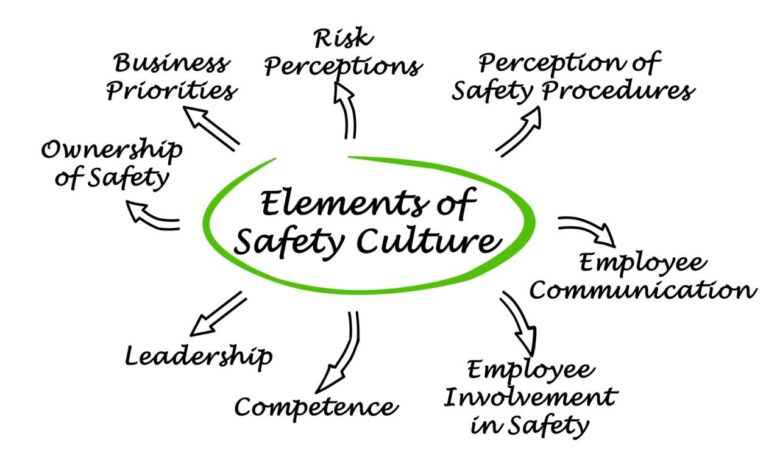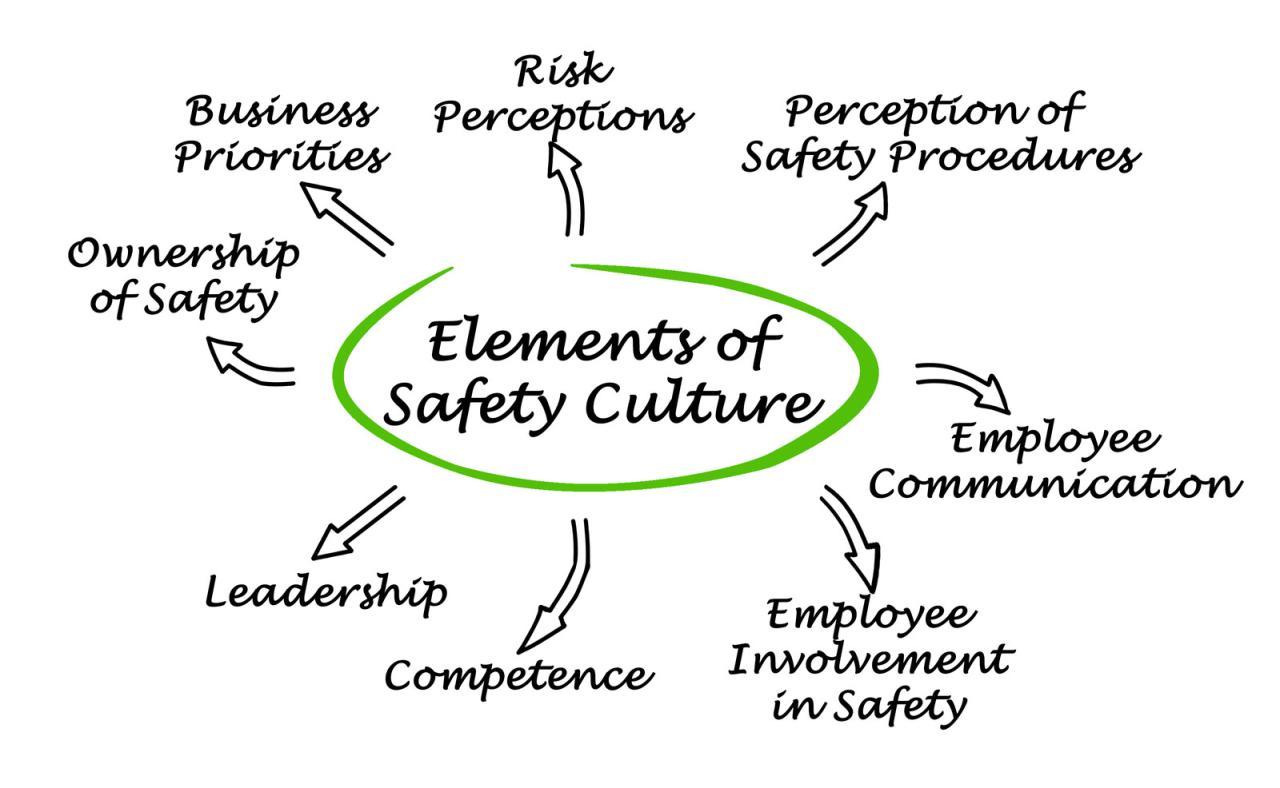
Safety Program Shaping Company Culture
Safety program shapes company culture, influencing everything from employee behavior to organizational performance. This isn’t just about avoiding accidents; it’s about fostering a positive and productive work environment where safety is valued and integrated into the core of the company’s identity. We’ll explore how a strong safety program can cultivate a culture of care, engagement, and ultimately, success.
From defining the program’s impact on various aspects of the organization to examining real-world case studies, we’ll dive deep into the crucial elements of building a safety-conscious culture. We’ll look at how a robust safety program can reduce workplace accidents, improve employee engagement, and boost overall organizational performance. Moreover, we’ll discuss how this extends beyond the workplace, impacting external stakeholders and the company’s reputation.
Defining Safety Program Impact
A robust safety program isn’t just a set of rules; it’s a cornerstone of a healthy organizational culture. It fosters a shared understanding of risk, encourages proactive measures, and ultimately contributes to a safer and more productive work environment. A well-implemented program empowers employees to prioritize safety and builds a culture where everyone feels valued and respected for their contributions to maintaining a safe workplace.A successful safety program goes beyond simply reducing accidents.
It shapes employee attitudes and behaviors, impacting the overall organizational culture. Measuring its influence requires a multi-faceted approach, looking at more than just incident rates. It necessitates evaluating changes in attitudes, behaviors, and communication patterns.
Defining a Safety Program
A safety program is a structured system of policies, procedures, and training designed to identify, assess, and mitigate workplace hazards. It aims to prevent accidents, injuries, and illnesses, thereby protecting employees and the organization from potential liabilities. The program’s core function is to create a culture where safety is paramount and integrated into all aspects of the work process.
Measuring Safety Program Effectiveness in Shaping Culture
Assessing the effectiveness of a safety program in shaping culture goes beyond simply counting incidents. Quantitative metrics like incident rates, near-miss reports, and training completion rates are essential but incomplete. Qualitative measures, such as employee surveys, focus groups, and observation of safety-related behaviors, provide a richer understanding of the program’s impact on the culture. Changes in employee attitudes and behaviors regarding safety protocols, along with improved communication and participation in safety initiatives, offer significant insights.
Influencing Employee Behavior and Attitudes
A safety program can profoundly influence employee behavior and attitudes by promoting a shared responsibility for safety. Effective training, clear communication of safety protocols, and regular reinforcement of best practices all contribute to positive behavioral changes. Employees who feel empowered to identify and report hazards, and who witness others adhering to safety standards, are more likely to adopt a proactive approach to safety themselves.
This can be seen in improved adherence to safety procedures, increased vigilance in hazard identification, and greater willingness to actively participate in safety initiatives.
Approaches to Fostering a Culture of Safety
Fostering a culture of safety within an organization requires a multi-pronged approach. This includes leadership commitment to safety, actively engaging employees in safety initiatives, promoting open communication channels for reporting hazards, and providing comprehensive safety training. Regular safety meetings, visible safety signage, and ongoing reinforcement of safety procedures are all vital components of creating a safety-conscious culture. Employee recognition programs for exemplary safety practices can further motivate individuals and teams to maintain and enhance safety standards.
Comparing Proactive and Reactive Safety Programs
| Characteristic | Proactive Safety Program | Reactive Safety Program |
|---|---|---|
| Focus | Preventing incidents through anticipation and risk mitigation. | Responding to incidents after they occur. |
| Culture Impact | Creates a culture of proactive hazard identification, risk assessment, and mitigation. Employees are empowered to identify and report hazards, fostering a sense of shared responsibility. | May lead to a culture of fear or blame if not managed effectively. Employees might be less likely to report hazards for fear of repercussions. Can be seen as a “fix-it-later” approach. |
| Employee Engagement | High employee engagement and participation in safety initiatives. | Employee engagement can be lower, with a focus potentially on compliance rather than proactive safety. |
| Cost Effectiveness | Generally more cost-effective in the long run by reducing the frequency and severity of incidents. | Can be more costly due to the need for extensive incident investigation, repairs, and potential legal implications. |
| Learning and Improvement | Continuous improvement and learning from near misses and incidents. | Learning is often limited to the specific incident, and the lessons learned might not be applied proactively. |
Elements of a Culture-Shaping Safety Program: Safety Program Shapes Company Culture
Building a strong safety culture isn’t just about implementing procedures; it’s about weaving safety into the very fabric of your company. A culture-shaping safety program goes beyond compliance; it fosters a mindset where safety is valued, prioritized, and actively championed by every employee. This approach dramatically reduces accidents and fosters a more engaged and productive workforce.A successful safety program needs to be deeply embedded in the company’s values and operations.
It requires active participation from all levels of the organization, from the CEO to the newest team member. This cultural shift starts with understanding the essential elements that influence safety consciousness and ensuring consistent messaging and action across the board.
Leadership Commitment
Leadership commitment is paramount in establishing a strong safety culture. Leaders who prioritize safety demonstrate that it’s not just a program, but a fundamental value. This commitment translates into resources, support, and consistent enforcement of safety policies. When leaders actively participate in safety initiatives, they set the tone for the entire organization. Visible support from top management significantly impacts employee engagement and perception of safety’s importance.
Furthermore, leaders should actively communicate the importance of safety and the associated consequences of non-compliance.
A strong safety program isn’t just about avoiding accidents; it fundamentally shapes company culture. A company like Oshkosh, known for its commitment to safety, is actively developing a new area near the Fox River, which is a testament to their proactive approach to growth and employee well-being. This demonstrates that prioritizing safety goes hand-in-hand with responsible expansion and building a strong, resilient company culture.
Communication and Transparency
Open communication and transparency are crucial for building trust and engagement in a safety program. Regular communication channels, including newsletters, safety meetings, and company-wide announcements, keep employees informed about safety policies, procedures, and incidents. Transparent reporting of near misses and incidents, without blame, fosters a culture of learning and improvement. This transparency demonstrates a commitment to continuous improvement and allows employees to feel safe voicing concerns and reporting potential hazards without fear of retribution.
Employee Involvement Strategies
Active employee involvement is essential for a safety-conscious culture. Employees are often the first to identify potential hazards or areas for improvement. Strategies like safety committees, suggestion boxes, and regular safety meetings empower employees to contribute actively to the safety program. Implementing these strategies can foster a sense of ownership and responsibility, resulting in more effective safety initiatives and a stronger safety culture.For example, a safety committee consisting of representatives from different departments can identify workplace hazards specific to their areas.
This can lead to practical solutions that address these hazards effectively.
Training Programs
Effective training programs are vital in fostering a safety-conscious culture. Comprehensive training should cover hazard identification, safe work practices, emergency procedures, and the company’s safety policies. Regular refresher courses reinforce knowledge and ensure that employees maintain their skills and awareness. Training should be engaging, interactive, and tailored to specific job roles and tasks. This ensures that employees understand the risks associated with their work and how to mitigate them.
Safety Program Communication Channels
| Communication Channel | Effectiveness | Description |
|---|---|---|
| Safety Meetings | High | Regular meetings provide a forum for discussion, Q&A, and updates. |
| Company Newsletter | Medium | Informative updates on safety initiatives and incidents. |
| Intranet | Medium | Provides access to safety materials, policies, and procedures. |
| Safety Posters/Visual Aids | Low-Medium | Visually engaging reminders and safety messages in high-traffic areas. |
| Employee Surveys | High | Gauge employee perceptions and identify areas for improvement. |
| Safety Committee Meetings | High | Focuses on employee input, problem-solving, and action planning. |
Safety Program and Employee Engagement
A robust safety program is not just about preventing accidents; it’s a powerful tool for fostering a positive and engaged workforce. When employees feel valued and protected, they are more likely to be invested in the company’s success. This connection between safety and engagement is a crucial aspect of any company culture aiming for excellence.A strong safety program goes beyond simply adhering to regulations.
It actively prioritizes employee well-being, fostering a sense of trust and shared responsibility for safety. This approach fosters a culture of proactive safety, where employees feel empowered to identify and report hazards, leading to a safer and more productive work environment.
The Connection Between Safety and Employee Engagement
Employee engagement is significantly influenced by the perceived safety of the workplace. When employees feel their well-being and safety are a top priority, they are more likely to be engaged, motivated, and committed to their work. Conversely, a lack of emphasis on safety can lead to decreased morale, increased stress, and reduced engagement. This is because employees perceive a lack of commitment to their safety as a lack of commitment to their well-being.
Safety Programs Supporting Employee Well-being
Safety programs that genuinely prioritize employee well-being often include comprehensive training, clear communication channels, and readily available resources for employees to report hazards and seek support. These programs acknowledge that safety is a shared responsibility, empowering employees to participate in safety initiatives. A good example is a program that offers stress management workshops, ergonomic assessments, and access to mental health resources.
These programs recognize the holistic nature of employee well-being and demonstrate a commitment to supporting the entire person, not just the employee as a worker.
Examples of Reducing Stress and Improving Morale
Strong safety programs can directly reduce employee stress by minimizing the risk of accidents and injuries. Regular safety meetings, clear safety procedures, and well-maintained equipment all contribute to a sense of security and predictability. This predictability reduces uncertainty, a major source of stress. For example, a construction company that proactively identifies and mitigates potential fall hazards, and provides appropriate safety gear, will likely see a reduction in stress among workers compared to a company that doesn’t proactively address these issues.
Improved morale is also a direct result of safety. When employees feel protected and valued, their morale naturally improves. This is further amplified by transparent communication and appreciation for their contributions to safety.
Opportunities for Recognition and Reward
Safety programs can incorporate opportunities for employee recognition and reward. This can be achieved through initiatives like safety suggestion boxes, contests for identifying hazards, or formal safety awards for individuals or teams. For example, a manufacturing company might award a safety certificate or bonus to employees who consistently demonstrate safe work practices or suggest improvements to safety procedures.
This creates a positive reinforcement loop, encouraging employees to actively participate in maintaining a safe work environment.
Employee Feedback Mechanisms for Improved Safety Programs
Implementing effective feedback mechanisms is critical for improving a safety program’s effectiveness. Regular feedback from employees allows the program to adapt to their needs and concerns. This ensures the program is relevant, practical, and meets the specific challenges faced in the workplace. Gathering feedback allows for adjustments and improvements, ensuring that the safety program is not only compliant but also proactively addresses emerging issues and improves efficiency.
Types of Employee Feedback Mechanisms
| Feedback Mechanism | Effectiveness | Description |
|---|---|---|
| Suggestion Boxes | Good | Simple and accessible, allows for anonymous feedback. |
| Safety Meetings | Excellent | Facilitates direct interaction and collective problem-solving. |
| Employee Surveys | Very Good | Provides a broader perspective and quantifiable data. |
| One-on-One Meetings | Excellent | Allows for in-depth discussions and personalized feedback. |
| Focus Groups | Excellent | Provides focused discussion on specific safety issues. |
Safety Program and Organizational Performance
A strong safety program isn’t just about preventing accidents; it’s a cornerstone of a thriving organization. A robust safety culture positively impacts every facet of the business, from employee well-being to bottom-line results. This interconnectedness is vital for long-term success and creates a more sustainable and productive work environment.A well-implemented safety program fosters a proactive mindset, reducing the likelihood of costly incidents and fostering a culture of continuous improvement.
This proactive approach, in turn, translates to tangible improvements in various organizational performance metrics.
Improved Organizational Performance Metrics
A robust safety culture directly correlates with enhanced organizational performance metrics. When employees feel safe and supported, they are more engaged and productive. This translates to higher quality work, fewer errors, and increased efficiency. Reduced downtime due to accidents and injuries frees up resources for other tasks, leading to greater output.
Correlation Between Safety Programs and Reduced Workplace Accidents
Safety programs, when implemented effectively, demonstrably reduce workplace accidents. Proactive risk assessments, comprehensive training programs, and consistent enforcement of safety protocols all contribute to a safer work environment. By identifying and mitigating potential hazards, organizations can dramatically lower the incidence of injuries and illnesses. This, in turn, lowers the cost of workers’ compensation claims and improves employee morale.
Influence of a Safety Culture on Productivity and Efficiency
A culture of safety directly impacts productivity and efficiency. When employees feel secure in their work environment, they can focus on their tasks without the constant fear of injury. This freedom from worry allows them to concentrate on their work, leading to increased output and improved efficiency. A safe work environment also reduces employee absenteeism due to injuries or illnesses, further contributing to productivity gains.
By creating a safer work environment, organizations cultivate a culture of high productivity and efficiency.
Link Between Safety Programs and Reduced Insurance Costs
A strong safety program can significantly reduce insurance costs. Companies with a history of low accident rates and a strong commitment to safety often receive favorable insurance premiums. This cost reduction is a direct result of lower claims associated with injuries and illnesses. Organizations demonstrate their commitment to safety and thus qualify for better insurance rates. A lower accident rate also translates into a reduction in compensation and medical expenses, which ultimately lowers insurance costs.
Impact of a Safety Program on Company Reputation
A strong safety program can positively influence a company’s reputation. By prioritizing the safety and well-being of its employees, an organization projects a responsible and caring image. This positive reputation can attract top talent, enhance stakeholder confidence, and improve the company’s brand image. Companies recognized for their commitment to safety tend to build a strong reputation for ethical conduct and responsibility.
Measurable Impacts of a Strong Safety Program
| Organizational Performance Metric | Measurable Impact of a Strong Safety Program |
|---|---|
| Accident Rate | Significant reduction in workplace accidents and injuries, leading to lower claim frequency and severity. |
| Employee Turnover | Improved employee satisfaction and retention due to a safer work environment, resulting in lower employee turnover costs. |
| Productivity | Increased employee focus and output due to reduced fear of injury, leading to higher productivity and efficiency. |
| Absenteeism | Lower rates of absenteeism due to fewer injuries and illnesses, leading to a more stable workforce. |
| Insurance Costs | Favorable insurance premiums due to lower accident rates and reduced claim costs. |
| Employee Morale | Enhanced employee morale and engagement due to a safe and supportive work environment. |
| Company Reputation | Improved company reputation due to a demonstrable commitment to employee safety and well-being. |
Safety Program and External Stakeholders

A robust safety program isn’t just about protecting employees; it’s a crucial element in building a strong company reputation and fostering positive relationships with external stakeholders. By prioritizing safety, companies demonstrate a commitment to ethical practices, responsible business operations, and a proactive approach to risk mitigation. This positive image extends beyond the workplace, impacting customer trust, supplier partnerships, and community well-being.A safety-conscious culture permeates all aspects of a company’s operations, influencing how it interacts with external entities.
Companies with strong safety programs are often seen as reliable partners, attracting customers who value safety and responsible practices. This translates to increased trust, positive brand perception, and ultimately, improved business performance.
Impact on Customers
A safe workplace directly influences customer trust and confidence. Customers are more likely to choose companies with a proven commitment to safety. This commitment fosters a sense of security and reliability, leading to stronger customer loyalty and repeat business. For instance, a company known for its rigorous safety standards in manufacturing may command a premium price for its products, reflecting the value placed on quality and safety.
A strong safety program isn’t just about avoiding accidents; it fundamentally shapes company culture. It fosters a sense of shared responsibility and trust, encouraging employees to look out for each other. This shared responsibility extends beyond the workplace, as evidenced by organizations like sustaining our waters the fox wolf watershed alliance , which demonstrates how a commitment to environmental stewardship can mirror a strong safety-conscious culture.
Ultimately, a proactive safety program builds a more engaged and responsible workforce.
Impact on Suppliers
Suppliers often partner with companies that share their values and prioritize safety. A company with a well-established safety program demonstrates a commitment to ethical sourcing and responsible business practices. This attracts reliable suppliers who align with their commitment to safety, leading to improved supply chain efficiency and quality. In the long term, suppliers who share a safety-oriented culture contribute to a safer working environment for everyone involved.
Impact on the Community
Companies with safety as a core value contribute positively to the surrounding community. A safe and healthy work environment minimizes the risk of accidents and injuries, thereby protecting both employees and the broader community. For example, a construction company that meticulously adheres to safety protocols reduces the potential for accidents on the job site and related environmental damage, positively impacting the local community’s well-being.
A strong safety program isn’t just about avoiding accidents; it fundamentally shapes a company’s culture, fostering a sense of shared responsibility and trust. This extends beyond the workplace, influencing how employees approach innovation and problem-solving. For instance, companies committed to safety often embrace a proactive approach to sustainability, like exploring the use of alternative materials in their processes, like in the burgeoning field of sustainable energy the future of sustainable energy looks to alternative materials.
Ultimately, a safety-conscious culture translates into a more resilient and forward-thinking organization.
Impact on Brand Image and Reputation
A strong safety program significantly impacts a company’s brand image and reputation. Companies perceived as prioritizing safety often attract and retain customers who value responsible practices. This perception can translate into increased market share and brand loyalty. Negative incidents, on the other hand, can severely damage a company’s reputation and lead to substantial financial losses. Consistent adherence to safety standards and procedures is vital for maintaining a positive image and building trust.
Attracting and Retaining Top Talent, Safety program shapes company culture
A safety-conscious culture can be a powerful tool for attracting and retaining top talent. Employees are more likely to be engaged and motivated in an environment where safety is prioritized. This environment fosters a sense of trust and respect, leading to increased productivity and reduced employee turnover. In a competitive job market, companies that emphasize safety can attract and retain skilled professionals.
Compliance with Regulations and Standards
A well-structured safety program facilitates compliance with relevant regulations and standards. By proactively addressing safety risks and implementing appropriate control measures, companies can minimize the likelihood of non-compliance issues. A systematic approach to safety fosters a culture of accountability and vigilance, reducing the risk of fines, penalties, and reputational damage. This proactive approach to compliance fosters trust with regulatory bodies and stakeholders.
Sustainability
A robust safety program directly contributes to a company’s overall sustainability. By prioritizing the well-being of employees, suppliers, and the community, companies foster a long-term, sustainable business model. Safety initiatives minimize environmental impact and prevent costly accidents and downtime, ultimately contributing to a more responsible and resilient business model.
Influence on External Stakeholders
| Stakeholder | Positive Influence of a Safety Program |
|---|---|
| Customers | Increased trust, stronger loyalty, and premium price perception. |
| Suppliers | Attracts reliable partners, improved supply chain efficiency, and enhanced quality. |
| Community | Minimized risk of accidents and injuries, and positive impact on the local environment. |
| Brand Image | Enhanced reputation, increased market share, and strengthened brand loyalty. |
| Top Talent | Attracts and retains skilled professionals, increased engagement, and reduced turnover. |
| Compliance | Facilitates compliance with regulations, reduced fines, and strengthened reputation with regulatory bodies. |
| Sustainability | Fosters a long-term, sustainable business model, minimized environmental impact, and reduced downtime. |
Illustrative Case Studies
Safety programs aren’t just about checklists and regulations; they’re deeply intertwined with the very fabric of a company’s culture. A strong safety culture, built on shared values and consistent practices, fosters a more engaged and productive workforce. Conversely, a weak safety program can breed mistrust, resentment, and even serious consequences. Examining real-world examples illuminates the profound impact safety programs have on company culture and performance.These case studies demonstrate how safety programs can be implemented to create a positive and productive work environment.
They also highlight the crucial role of leadership in establishing and maintaining a safety-conscious culture. The lessons learned from these experiences can serve as valuable insights for organizations striving to cultivate a culture of safety.
A Successful Safety Program Shaping Culture
The manufacturing company “ProSafe Industries” implemented a comprehensive safety program that emphasized proactive risk assessment, regular training, and employee involvement. Employees were empowered to identify potential hazards and suggest solutions. The company invested heavily in safety equipment and training, making it a priority for every employee. This resulted in a significant decrease in accidents and injuries. More importantly, a sense of shared responsibility for safety permeated the company culture.
Employees felt valued and empowered to contribute to a safer work environment, leading to higher morale and productivity. This positive feedback loop created a culture of continuous improvement and a deep respect for safety procedures.
A Company with a Weak Safety Program and Its Impact
“TechForce Solutions,” a rapidly growing tech company, initially prioritized rapid growth over safety. The company’s early success was fueled by long hours and intense pressure to meet deadlines. Safety protocols were often overlooked, and training was minimal. This resulted in a culture of cutting corners and a disregard for safety procedures. The accumulation of minor injuries escalated into more serious incidents, leading to a loss of productivity and a decline in employee morale.
The company’s reputation suffered, and attracting and retaining skilled talent became increasingly challenging.
Cultural Evolution After a Major Safety Incident
“Innovate Corp,” a leading aerospace company, experienced a critical safety incident that resulted in significant injuries. The incident prompted a thorough investigation, which exposed weaknesses in the company’s safety protocols and communication channels. In response, Innovate Corp implemented a new safety program that focused on transparent communication, leadership accountability, and a culture of open discussion. The company established a dedicated safety committee, allowing employees to voice concerns without fear of retribution.
This initiative fostered a culture of psychological safety, where employees felt comfortable reporting potential hazards and discussing safety concerns. The company’s culture evolved from one that tolerated risks to one that valued proactive safety measures.
Comparison of Safety Program Implementations
To illustrate the different approaches to safety program implementation, consider “Greenfield Solutions,” a construction company that prioritizes worker safety as a core value, and “RapidRise Builders,” a rapidly expanding construction company that has prioritized efficiency over safety.
- Greenfield Solutions implemented a comprehensive safety program with clear protocols and consistent enforcement. Regular training and safety audits were a cornerstone of their approach. Employees received ongoing feedback and were actively involved in the development and implementation of safety procedures.
- RapidRise Builders focused on cost-effectiveness, often sacrificing safety measures in the name of speed. Safety training was minimal and compliance was inconsistently enforced. There was a significant lack of employee engagement in safety initiatives.
Lessons Learned from Case Studies
These case studies highlight the critical importance of proactive safety measures, strong leadership commitment, and continuous improvement in fostering a positive safety culture. Ignoring safety can lead to significant financial and reputational damage, while prioritizing safety fosters a productive and engaged workforce. Consistent enforcement of safety protocols and employee engagement in safety initiatives are essential for sustainable improvements.
Comparative Analysis of Safety Programs
| Aspect | Greenfield Solutions | RapidRise Builders |
|---|---|---|
| Leadership Commitment | High; safety is a core value | Low; efficiency prioritized over safety |
| Employee Involvement | High; employees actively participate in safety initiatives | Low; minimal employee input in safety processes |
| Training Frequency | High; regular and comprehensive training | Low; infrequent and often superficial training |
| Safety Audit Frequency | High; regular audits to identify and address potential hazards | Low; infrequent or nonexistent audits |
| Safety Equipment Provision | High; adequate and up-to-date equipment | Low; potentially inadequate or outdated equipment |
Final Review

In conclusion, a safety program that shapes company culture is not a mere checklist of procedures, but a powerful driver of positive change. By prioritizing safety, organizations can create a more engaged and productive workforce, enhance their reputation, and ultimately achieve long-term success. The examples and insights shared in this piece highlight the profound impact a well-implemented safety program can have on the entire organization.





